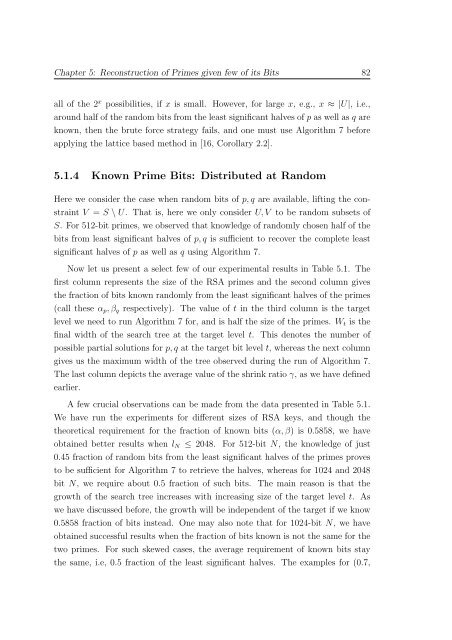Cryptanalysis of RSA Factorization - Library(ISI Kolkata) - Indian ...
Cryptanalysis of RSA Factorization - Library(ISI Kolkata) - Indian ...
Cryptanalysis of RSA Factorization - Library(ISI Kolkata) - Indian ...
You also want an ePaper? Increase the reach of your titles
YUMPU automatically turns print PDFs into web optimized ePapers that Google loves.
Chapter 5: Reconstruction <strong>of</strong> Primes given few <strong>of</strong> its Bits 82<br />
all <strong>of</strong> the 2 x possibilities, if x is small. However, for large x, e.g., x ≈ |U|, i.e.,<br />
around half <strong>of</strong> the random bits from the least significant halves <strong>of</strong> p as well as q are<br />
known, then the brute force strategy fails, and one must use Algorithm 7 before<br />
applying the lattice based method in [16, Corollary 2.2].<br />
5.1.4 Known Prime Bits: Distributed at Random<br />
Here we consider the case when random bits <strong>of</strong> p,q are available, lifting the constraint<br />
V = S \U. That is, here we only consider U,V to be random subsets <strong>of</strong><br />
S. For 512-bit primes, we observed that knowledge <strong>of</strong> randomly chosen half <strong>of</strong> the<br />
bits from least significant halves <strong>of</strong> p,q is sufficient to recover the complete least<br />
significant halves <strong>of</strong> p as well as q using Algorithm 7.<br />
Now let us present a select few <strong>of</strong> our experimental results in Table 5.1. The<br />
first column represents the size <strong>of</strong> the <strong>RSA</strong> primes and the second column gives<br />
the fraction <strong>of</strong> bits known randomly from the least significant halves <strong>of</strong> the primes<br />
(call these α p ,β q respectively). The value <strong>of</strong> t in the third column is the target<br />
level we need to run Algorithm 7 for, and is half the size <strong>of</strong> the primes. W t is the<br />
final width <strong>of</strong> the search tree at the target level t. This denotes the number <strong>of</strong><br />
possible partial solutions for p,q at the target bit level t, whereas the next column<br />
gives us the maximum width <strong>of</strong> the tree observed during the run <strong>of</strong> Algorithm 7.<br />
The last column depicts the average value <strong>of</strong> the shrink ratio γ, as we have defined<br />
earlier.<br />
A few crucial observations can be made from the data presented in Table 5.1.<br />
We have run the experiments for different sizes <strong>of</strong> <strong>RSA</strong> keys, and though the<br />
theoretical requirement for the fraction <strong>of</strong> known bits (α,β) is 0.5858, we have<br />
obtained better results when l N ≤ 2048. For 512-bit N, the knowledge <strong>of</strong> just<br />
0.45 fraction <strong>of</strong> random bits from the least significant halves <strong>of</strong> the primes proves<br />
to be sufficient for Algorithm 7 to retrieve the halves, whereas for 1024 and 2048<br />
bit N, we require about 0.5 fraction <strong>of</strong> such bits. The main reason is that the<br />
growth <strong>of</strong> the search tree increases with increasing size <strong>of</strong> the target level t. As<br />
we have discussed before, the growth will be independent <strong>of</strong> the target if we know<br />
0.5858 fraction <strong>of</strong> bits instead. One may also note that for 1024-bit N, we have<br />
obtained successful results when the fraction <strong>of</strong> bits known is not the same for the<br />
two primes. For such skewed cases, the average requirement <strong>of</strong> known bits stay<br />
the same, i.e, 0.5 fraction <strong>of</strong> the least significant halves. The examples for (0.7,
















